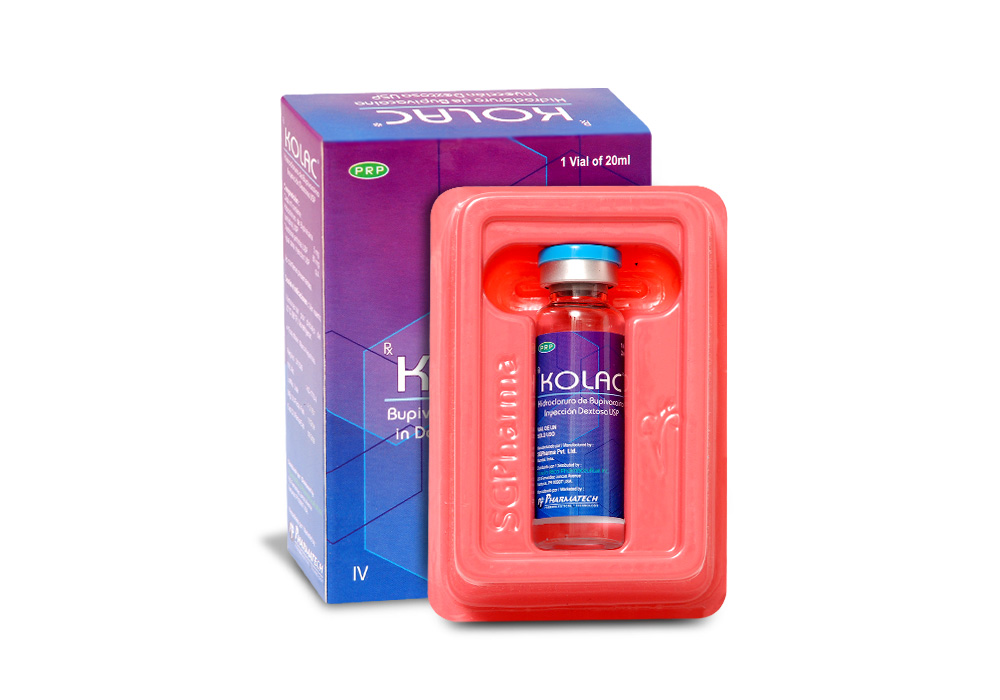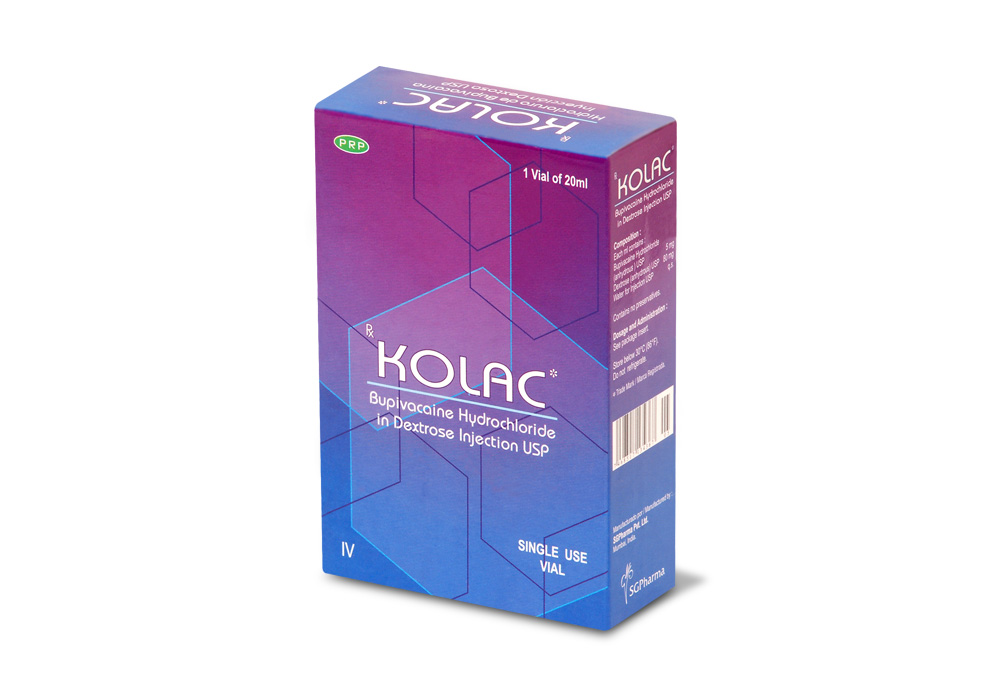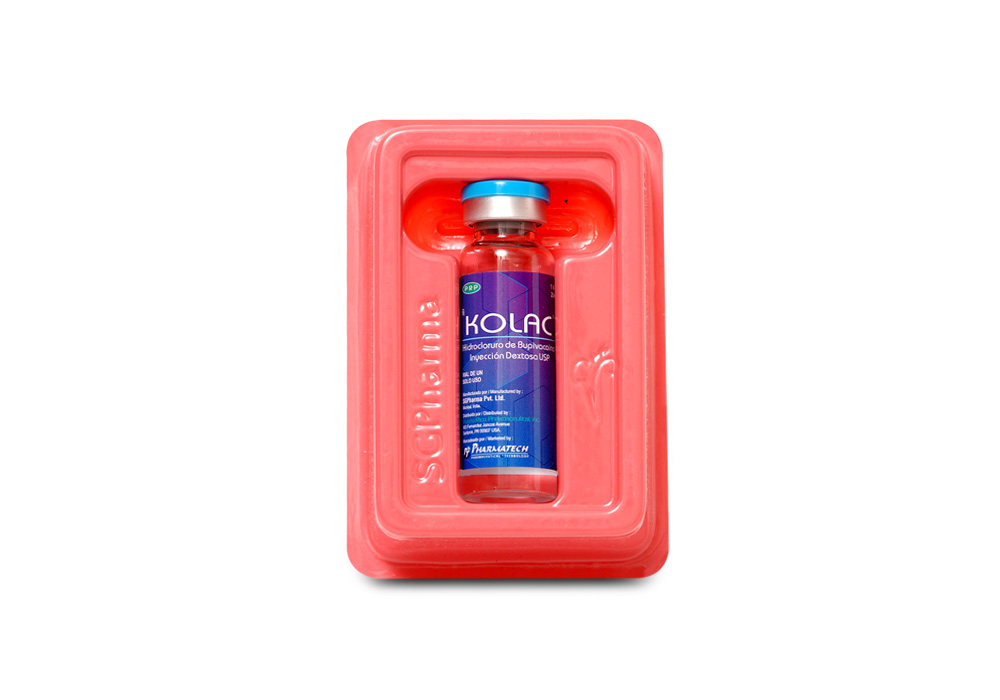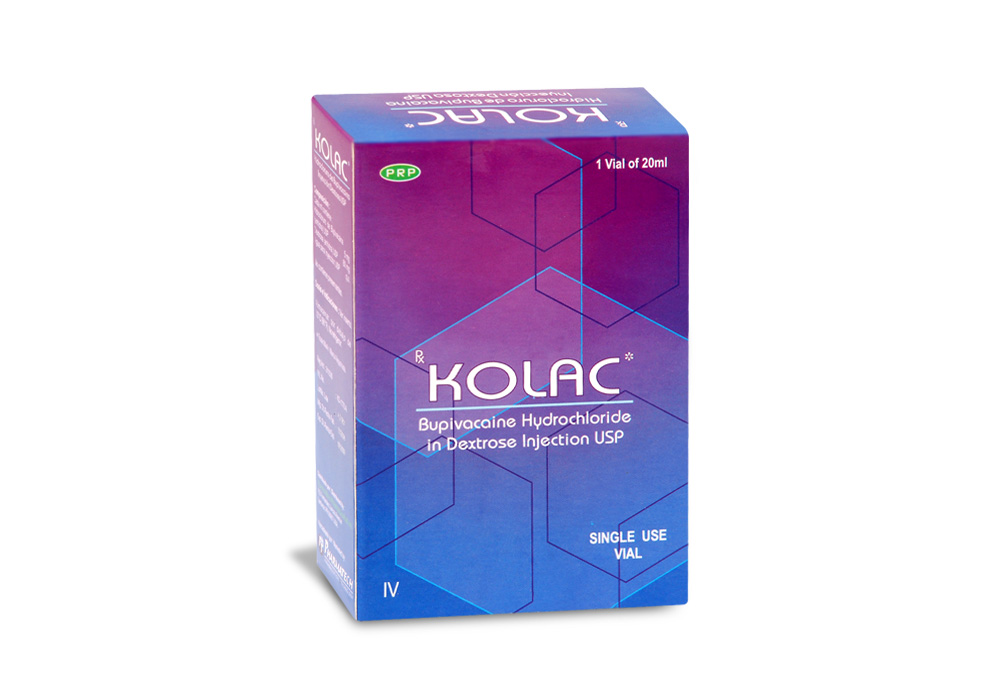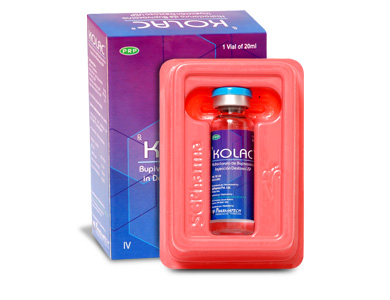
5 mg+80 mg/ml,
4 ml & 20 ml
For the use of a Registered Medical Practitioner or a Hospital or a Institution only.
KOLAC (Bupivacaine hydrochloride) is a long acting anaesthetic agent of the amide type. Chemically, Bupivacaine hydrochloride is 2-Piperidinecarboxamide, 1-butyl-N-(2,6-dimethylphenyl)-,monohydrochloride, monohydrate. The molecular formula is
C18H28N2O·HCl·H2O and the molecular weight is 342.90.
STRUCTURAL FORMULA :
Its structural formula is :
-Structure.jpg)
KOLAC is a clear, colourless sterile solution filled in 20 mL flint tubular vial. Solution contains no preservative (antimicrobial agent) and should be used once and any residue to be discarded.
COMPOSITION :
Each ml contains :
Bupivacaine Hydrochloride
(anhydrous) USP 5 mg
Dextrose (anhydrous) USP 80 mg
Water for Injection USP q.s.
Contains no preservatives.
ACTIONS :
Bupivacaine is a local anaesthetic of the amide type, chemically related to mepivacaine. Bupivacaine, like other local anaesthetics, causes a reversible blockade of impulse propagation along nerve fibres by preventing the inward movement of sodium ions through the
nerve membrane. Local anaesthetics of the amide type are thought to act within the sodium channels of the nerve membrane. KOLAC produces moderate muscle relaxation in the lower extremities lasting 2-3 hours. Motor blockade of the abdominal muscles makes the solution suitable for performance of abdominal surgery lasting 1.5-2 hours. The duration of motor blockade does not exceed the duration of analgesia.
PHARMACOKINETICS :
Rapid onset of action and long duration i.e. T10 -T12 segments - duration 2-3 hours. Muscular relaxation of lower extremities lasts 2 - 2.5 hours. Blockade of the abdominal muscles lasts 45-60 minutes. The duration of motor blockade does not exceed duration of analgesia. Bupivacaine has a pKa of 8.1 and is extensively bound to plasma proteins (95 %). Bupivacaine exhibits a high degree of lipid solubility with an oil/water partition coefficient of 27.5. These factors contribute to its prolonged duration of action. Bupivacaine has a total plasma clearance of 0.58 L/min, a volume of distribution at steady state of 73 L, an elimination half-life of 2.7 hours and an intermediate hepatic extraction ratio of 0.40. Clearance of bupivacaine is almost entirely due to liver metabolism, and depends upon both liver blood flow and enzyme activity. The major pathway is thought to be N-dealkylation to 2,6-pipecoloxylidide (PPX). Only 6 % of bupivacaine is excreted unchanged in the urine, the main metabolites being PPX and its derivatives. Unbound bupivacaine readily crosses the placenta in equilibrium with the mother. Only about 5 % of bupivacaine is unbound and available for transfer and foetal protein binding is low compared to the mother so that the total plasma concentration (free plus bound) will be lower in the foetus than in the mother.
INDICATIONS :
KOLAC is indicated for intrathecal (subarachnoid, spinal) anaesthesia for surgical and obstetrical procedures. KOLAC is indicated for lower abdominal surgery (including Caesarean section), urological and lower limb, including hip surgery, lasting 1.5 to 3 hours.
Administration :
By intrathecal injection.
Dosage :
The doses recommended below should be regarded as a guide for use in the average adult. Intrathecal anaesthesia for surgery : 2-4 mL (10-20 mg bupivacaine hydrochloride). The dose should be reduced in the elderly and in patients in the later stages of pregnancy.
The spread of anaesthesia obtained with bupivacaine depends on several factors including the volume of solution and the position of the patient during and following the injection. When injected at the L3-L4 intervertebral space, with the patient in the sitting position, 3 mL of bupivacaine spreads to the T7-T10 spinal segments. With the patient receiving the injection in the horizontal position and then turned supine, the blockade spreads to T4-T7 spinal segments. It should be understood that the level of spinal anaesthesia achieved with any local
anaesthetic can be unpredictable in a given patient. The recommended site of injection is below L3. The effects of injections of KOLAC exceeding 4 mL have not yet been studied and such volumes can therefore not be recommended.
Hypotension :
During spinal anaesthesia, a marked fall in blood pressure and/or intercostal paralysis may be seen, possibly due to the use of excessive doses or improper positioning of the patient. Hypotension and bradycardia may occur as a result of sympathetic blockade.|
Standard textbooks should be consulted with respect to techniques for administration of (bupivacaine) for spinal anaesthesia.
Paediatrics :
KOLAC may be used in children. One of the differences between small children and adults is a relatively high CSF volume in infants and neonates, requiring a relatively larger dose/kg to produce the same level of block as compared to adults.
CONTRAINDICATIONS :
General contraindications related to intrathecal anaesthesia should be taken into account :
Absolute :
1. Allergy or hypersensitivity to amide type local anaesthetics. Detection of suspected sensitivity by skin testing is of limited value.
2. Acute active diseases of the cerebrospinal system such as meningitis, tumours (primary or secondary), poliomyelitis, subacute combined degeneration of the spinal cord, cranial haemorrhage, demyelinating disease and raised intracranial pressure.
3. Spinal stenosis and active disease (e.g. spondylitis, tumour) or recent trauma (e.g. fracture) in the vertebral column.|
4. Local anaesthetic techniques must not be used when there is inflammation and/or sepsis in the region of the proposed injection or in the presence of septicaemia.
5. Uncorrected hypotension, cardiogenic or hypovolaemic shock.|
6. Coagulation disorders or ongoing anti-coagulation treatment.|
7. Pernicious anaemia with subacute combined degeneration of the spinal cord.
Relative :
Arthritis and other diseases of the vertebral column are relative contraindications due to technical difficulties in performing a spinal injection.
WARNINGS AND PRECAUTIONS :
Intrathecal anaesthesia should only be undertaken by clinicians with the necessary knowledge and experience. Regional anaesthetic procedures should always be performed in a properly equipped and staffed area. Resuscitative equipment and drugs should be|
immediately available and the anaesthetist should remain in constant attendance. Intravenous access, e.g. an I.V. infusion, should be in place before starting the intrathecal anaesthesia. The clinician responsible should take the necessary precautions to avoid intravascular injection and be appropriately trained and familiar with the diagnosis and treatment of side effects, systemic toxicity and other complications. If signs of acute systemic toxicity or total spinal block appear, injection of the local anaesthetic should be stopped immediately. Like all local anaesthetic drugs, bupivacaine may cause acute toxicity effects on the central nervous and cardiovascular systems, if utilised for local anaesthetic procedures resulting in high blood concentrations of the drug. This is especially the case after unintentional intravascular administration or injection into highly vascular areas.
Ventricular arrhythmia, ventricular fibrillation, sudden cardiovascular collapse and death have been reported in connection with high systemic concentrations of bupivacaine. Should cardiac arrest occur, a successful outcome may require prolonged resuscitative efforts.
High systemic concentrations are not expected with doses normally used for intrathecal anaesthesia. There is an increased risk of high or total spinal blockade, resulting in cardiovascular and respiratory depression, in the elderly and in patients in the later stages of pregnancy. The dose should therefore be reduced in these patients. Intrathecal anaesthesia with any local anaesthetic can cause hypotension and bradycardia which should be anticipated and appropriate precautions taken. These may include preloading the circulation with crystalloid or colloid solution. If hypotension develops it should be treated with a vasopressor such as ephedrine 10-15 mg intravenously. Severe hypotension may result from hypovolaemia due to haemorrhage or dehydration, or aorto-caval occlusion in patients with massive ascites, large abdominal tumours or late pregnancy. Marked hypotension should be avoided in patients with cardiac decompensation. Patients with hypovolaemia due to any cause can develop sudden and severe hypotension during intrathecal anaesthesia.
Intrathecal anaesthesia can cause intercostal paralysis and patients with pleural effusions may suffer respiratory embarrassment. Septicaemia can increase the risk of intraspinal abscess formation in the postoperative period. Before treatment is instituted, consideration should be taken if the benefits outweigh the possible risks for the patient. Patients in poor general condition due to ageing or other compromising factors such as partial or complete heart conduction block, advanced liver or renal dysfunction require special attention, although regional anaesthesia may be the optimal choice for surgery in these patients.
Pregnancy :
There is no evidence of untoward effects in human pregnancy. In large doses there is evidence of decreased pup survival in rats and an embryological effect in rabbits if bupivacaine is administered in pregnancy. Bupivacaine should not therefore be given in early pregnancy unless the benefits are considered to outweigh the risks. It should be noted that the dose should be reduced in patients in the later stages of pregnancy.
Lactation :
Bupivacaine enters the mothers milk, but in such small quantities that there is generally no risk of affecting the child at therapeutic dose levels.
Effect on ability to drive and use machine :
Besides the direct anaesthetic effect, local anaesthetics may have a very mild effect on mental function and coordination even in the absence of overt CNS toxicity and may temporarily impair locomotion and alertness.
INTERACTIONS AND INCOMPATIBILITIES :
Anti-arrhythmic agents :
Bupivacaine should be used with caution in patients receiving other local anaesthetics or agents structurally related to amide-type local anaesthetics, e.g. tocainide, since the systemic toxic effects are additive. SIDE EFFECTS : In general, almost all the side effects seen with spinal anaesthesia are due to the nerve blockade itself and not to the agent used. These effects include hypotension, bradycardia and post dural puncture headache.
High or Total Spinal Blockade :
Severe adverse reactions following spinal bupivacaine are rare but may occur in connection with extensive (total) spinal blockade. Total spinal blockade will result in cardiovascular and respiratory depression. The cardiovascular depression is caused by an extensive
sympathetic blockade which may result in profound hypotension and bradycardia, or even cardiac arrest. Ventilatory depression is caused by blockade of respiratory muscles including the diaphragm.
Acute systemic toxicity :
In view of the low dosage employed, systemic adverse reactions are rarely associated with spinal anaesthesia. Systemic adverse reactions are characterised by numbness of the tongue, light-headedness, dizziness and tremor followed by convulsions and cardiovascular
reactions. The cardiovascular reactions are depressant and may be characterised by hypotension, myocardial depression, bradycardia and possibly cardiac arrest.
Allergy :
Allergy to amide type local anaesthetics is very rare but may be present as allergic dermatitis, bronchospasm or anaphylaxis.
Neurological reactions :
Neurological damage is a rare, though recognised, consequence of spinal anaesthesia. It may have one of several causes such as direct injury to the spinal cord or spinal nerves, anterior spinal artery syndrome, injection of an irritant substance, injection of a nonsterile
solution or the development of a space occupying lesion (haematoma or abscess) within the spinal canal. These may result in localised areas of paraesthesia or anaesthesia, motor weakness, loss of sphincter control and paraplegia. Occasionally these are permanent. Neurological complications of this type have been reported with all local anaesthetics used for spinal anaesthesia.
OVERDOSAGE :
KOLAC used as recommended, is not likely to cause blood levels high enough to cause systemic toxicity. However, if other local anaesthetics are concomitantly administered, toxic effects are additive and may cause systemic toxic reactions. Systemic toxicity is rarely associated with spinal anaesthesia but might occur after accidental intravascular injection. Systemic adverse reactions are characterised by numbness of the tongue, lightheadedness, izziness and tremors, followed by convulsions and cardiovascular disorders.
TREATMENT OF OVERDOSAGE :
Treatment of systemic toxicity :
No treatment is required for milder symptoms of systemic toxicity but if convulsions occur then it is important to ensure adequate oxygenation and to arrest the convulsions if they last more than 15-30 seconds. Oxygen should be given by face mask and the respiration assisted or controlled if necessary. Convulsions can be arrested by injection of thiopentone 100-150 mg intravenously or with diazepam 5-10 mg intravenously. Alternatively, succinylcholine 50-100 mg intravenously may be given but only if the clinician has the ability to perform endotracheal intubation and to manage a totally paralysed patient.
STORAGE :
Store below 30°C (86°F).
Do not refrigerate.
SHELF LIFE :
36 months from the date of manufacture.
PRESENTATION :
KOLAC is aqueous solution supplied in 20 mL flint tubular glass vial containing Bupivacaine Hydrochloride (anhydrous) USP 5 mg Dextrose (anhydrous) USP 80 mg.
Disclaimer : For the use of a Registered Medical Practitioner or a Hospital or a Institution only. Also it is not intended to be used by healthcare professionals or patients for the purpose of prescribing or administering these products. Questions regarding the complete and current content of product labeling / specification / presentation should be directed to SGPharma.

 Cardiovascular
Cardiovascular



